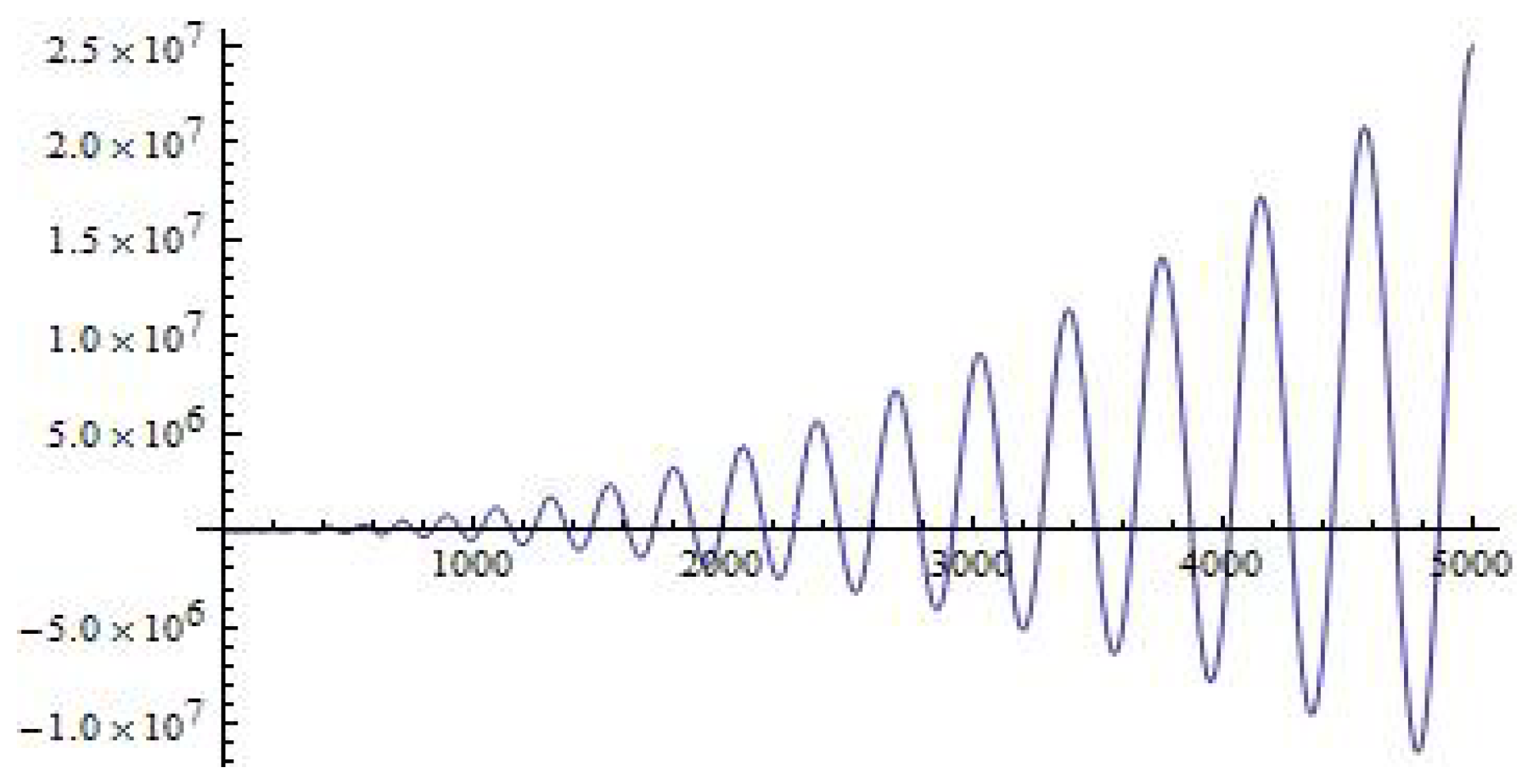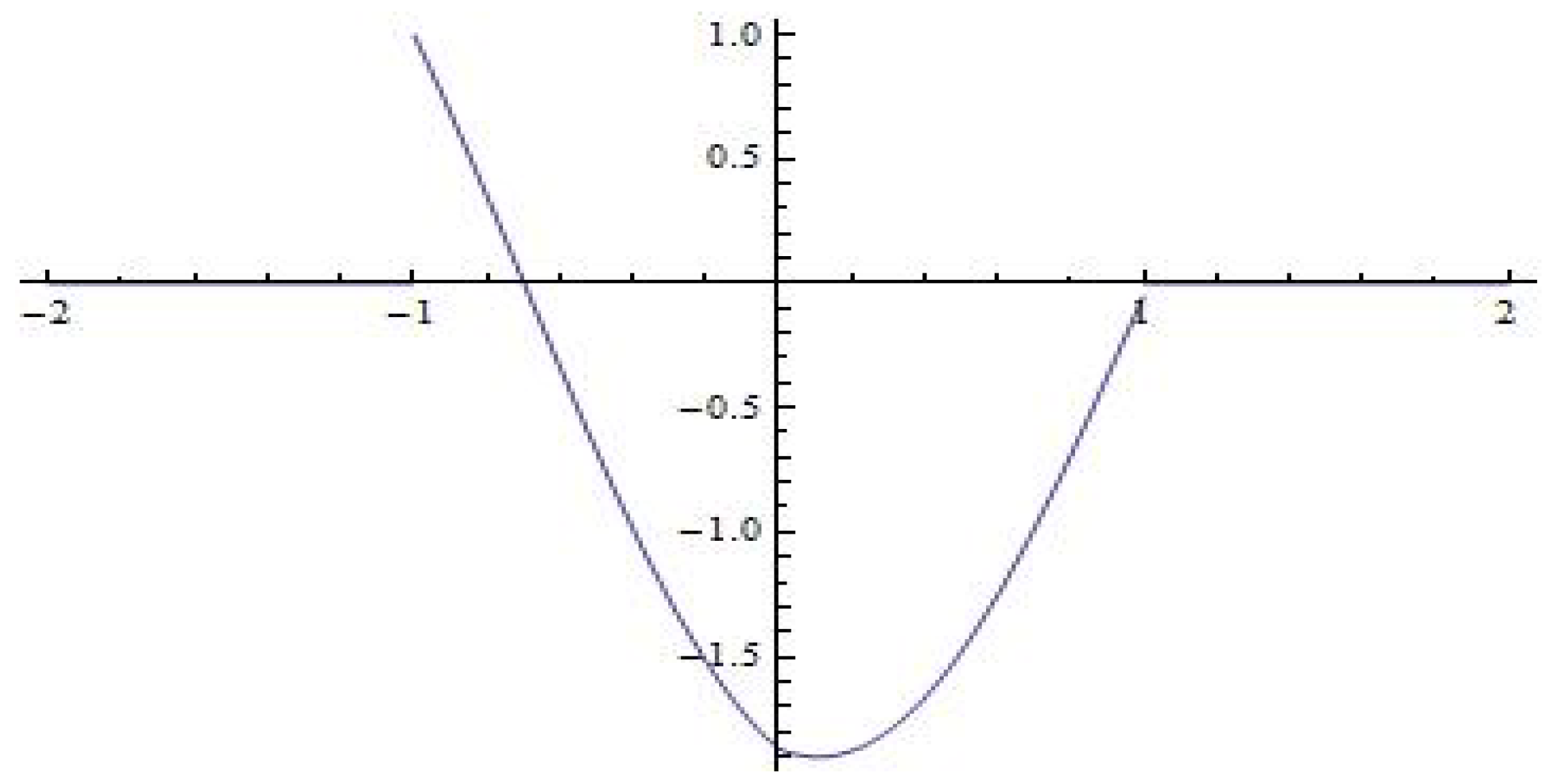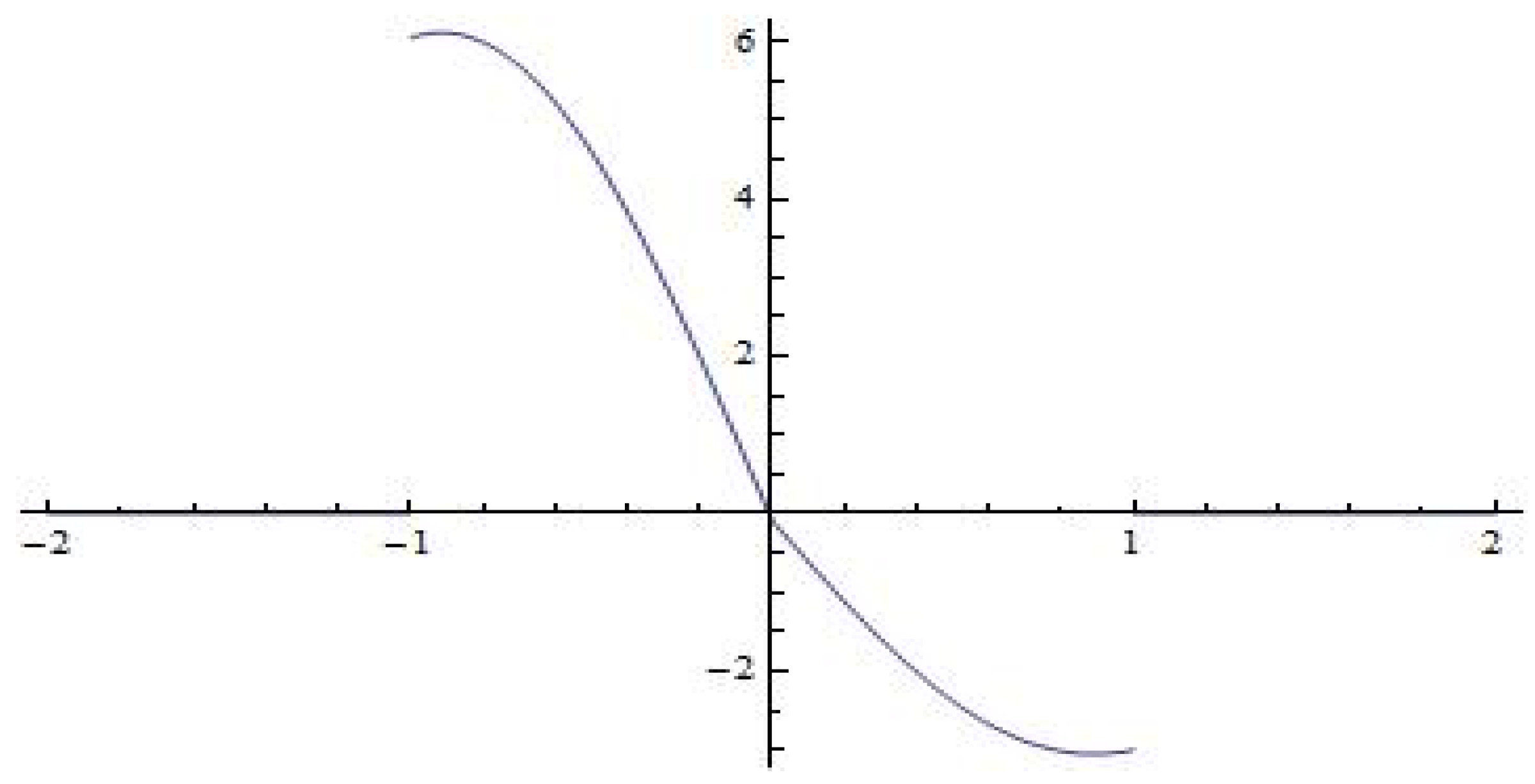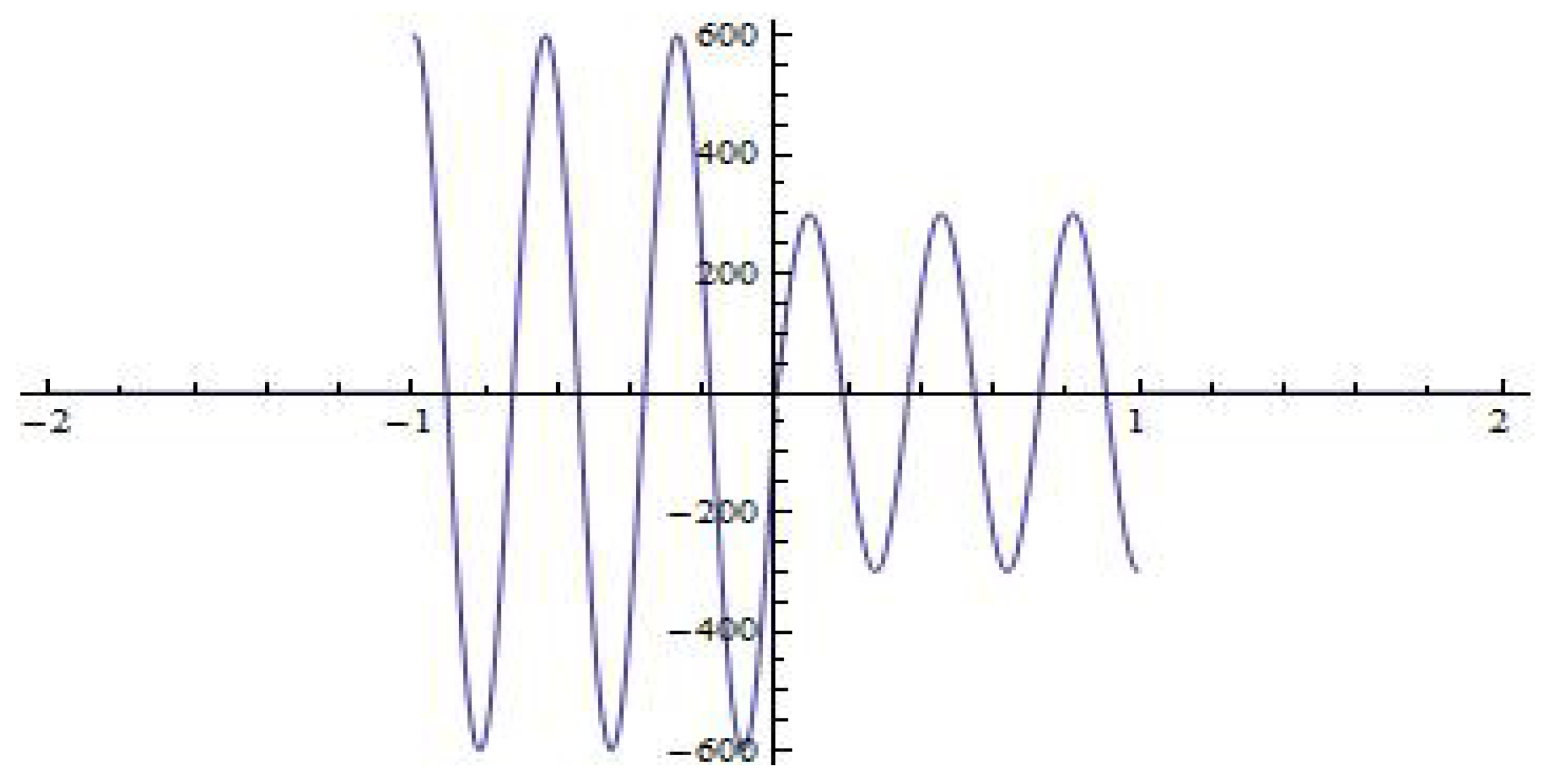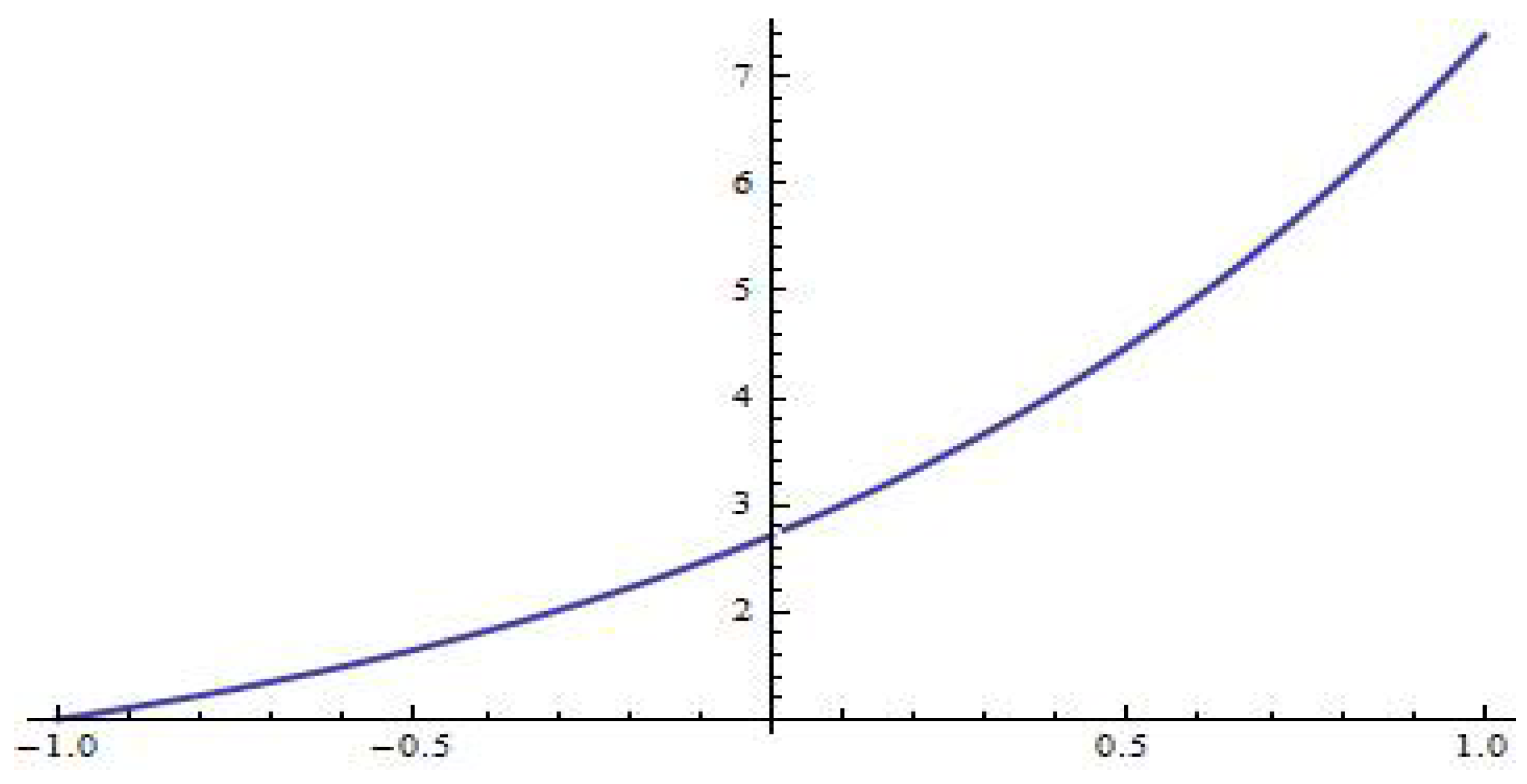1. Introduction
In this study we are interested in the eigenvalues and eigenfunctions of two-interval Sturm–Liouville problems that arise when modeling many real problems appearing in physics, engineering and other branches of natural science. For example, they arise when considering Kirchoff’s law in electrical circuits, the balance of tension in elastic, the steady-state temperature in a heated rod, the vibrations of a string or the energy eigenfunctions of a quantum mechanical oscillator, in which eigenvalues correspond to the resonant frequencies or energy levels (See, [
1,
2]).
It is evident that not all equations of Sturm–Liouville type have exact solutions. Some special cases are solved by different numerical methods, such as the Runge–Kutta method, the finite difference method, the shooting method, the weighed residual method, Picard’s successive approximation method, the variational iteration method and the differential transformation method.
Chen and Ho [
3] used the differential transformation method (DTM) to calculate the eigenvalues of the linear Sturm–Liouville problem
and the results were compared with those calculated by other analytical methods. Golmankhaneh et al. [
4] used the homotop perturbation method (HPM), the variational iteration method (VIM) and the new iteration method (NIM) for finding approximation solutions of nonlinear Sturm–Liouville equation
with the initial conditions
where
By comparing the obtained results, they deduced that HPM gives better approximation solutions than VIM and NIM.
In the 1980s, George Adomian [
5,
6,
7] developed a new decomposition method, called the Adomian decomposition method (ADM), for solving linear or nonlinear equations; ordinary or partial differential equations; various types of integral, algebraic and delay equations; and stochastic systems. An advantage of this method is that it can provide analytical approximations to a rather wide class of problems requiring no linearization, perturbation, closure approximations or discretization methods, which can require massive numerical computation.
S. Somali and G. Gokmen [
8] considered ADM for computing eigenvalues and eigenfunctions of nonlinear Sturm–Liouville equation
together with simple boundary conditions
By using the shooting technique and the direct integrating method, Malathi et al. [
9] computed eigenvalues of periodic Sturm–Liouville problems.
Attili et al. [
10] used ADM for computing eigenvalues of a one-interval boundary value problem for the Sturm–Liouville equation. Al-Hayani [
11] considered a modified ADM to solve linear and nonlinear boundary-value problems with Neumann boundary conditions. Momani and Noor [
12] used the DTM, ADM and HPM for solving a special class of boundary value problems for a fourth-order ordinary differential equation.
Recently a great deal of interest has been focused on the application of different types of approximation methods for the solutions of linear and nonlinear problems (See, [
13,
14,
15,
16,
17]).
Bibi and Merahi [
13] derived approximate solutions of linear stochastic differential equations. They showed the efficiency of ADM in the field of sthochastic differential equations. Erturk and Momani [
18] presented a numerical comparison between DTM and ADM applied to the solution of fourth-order boundary value problems.
We will be interested in the computation of the eigenvalues and eigenfunctions of a new type of SLPs (Sturm–Liouville problems), the main feature of which is the nature of the boundary conditions imposed. Namely, the boundary conditions contain not only end points of the considered interval, but also an interior point of discontinuity at which given supplementary conditions are called transmission conditions. Moreover, the spectral parameter appears not only in the differential equation, but also in the boundary conditions. Such two-interval boundary value problems arise in various type problems of natural science, such as in heat and mass transfer problems; diffraction problems; vibrating string problems when the string is loaded additionally with point masses; and thermal conduction problems for a thin laminated plate.
We want emphasize that two-interval boundary-value problems with additional transmission conditions are much more complicated to solve than one-interval boundary value problems. The existence and uniqueness theorems for the solution of a two-interval boundary value transmission problem (BVTP) can be found in many articles by the first author and his collaborators (see, for example, [
19,
20,
21,
22,
23,
24].)
The organization of the rest of this study will be as follows. In
Section 2 we explain the application of the Adomian decomposition method to computing the solution of the linear and nonlinear Sturm–Liouville equations. In
Section 3 we present a new analytical method for the computing of exact eigenelements. In
Section 4 we adapt the ADM to obtain approximate values of eigenvalues and eigenfunctions.
Remark 1. Our motivation for this work comes from the problem regarding the Earth’s seismic behavior, the stability and velocity of large-scale waves in the atmosphere, etc. If the Earth is assumed to be spherically symmetric and non-rotating, and to consist of an isotropic, perfect elastic medium, then the mathematical model can be written in singular Sturm–Liouville form with interior discontinity, where discontinuities in the elastic parameters are transformed to discontinuities in the eigenfunctions. The transmission conditions for the solutions come from continuity of displacement and stress at an interface. Since the Earth has several discontinuities in the upper mantle, we are motivated to consider singular Sturm–Liouville problems with additional transmission conditions at one interior point of discontinuity.
2. Outline of the Decomposition Method for Linear and Nonlinear Sturm–Liouville Problems
Let us recall basic principles of the Adomian decomposition method (see [
5,
6,
7]) for solving linear or nonlinear differential equations of the form
where the operator
F is the differential operator involving both linear and nonlinear terms. The linear term is decomposed into
, where
L is highest order derivation and
R is the reminder of the linear term. Thus, the equation
may be rewritten in the following form.
Here
represents the nonlinear term. Since the highest order derivation operator
L is easily invertable, from (
1) we have
A solution we can be expanded as following series
and the nonlinear term
can be decomposed by the infinite series of polynomials
, so-called Adomian polynomials, as
where
and so on. Then with a reasonable
which may be identified with respect to the representation of the inverse operator
, we have the following recurrence formula.
Now consider the Sturm–Liouville equation
where the function
is continuously differentiable and nonzero for all
x, and
is a continuous function. Define the Adomian’s operators L, R and N as
The Equation (
4) reduces to an operator form
By integrating twice, the equation
we see that the inverse operator
has the form
Operating
on both sides of the operator, Equation (
5) yields
The ADM assumes that the solution y of the Equation (
6) can be decomposed into an infinite series
Now, assuming
is analytic, we can write
where the terms
are specially defined polynomials (so-called Adomian polynomials), which depend only on the first
components and form a rapidly convergent series (see [
7]). These polynomials are defined by
The solution
can now be written as
Therefore, in accordance with the well-known fixed-point theorem, we can choose successive approximations
of the solution
as
and so on.
The first approximation
can be obtained by using initial and boundary conditions. Thus we have recurrence formulas (8) and (9) for obtaining other components
of the decomposition (
7). Convergence of this decomposition and rapidity of this convergence have been established by Y. Cherrualt [
25].
3. A New Analytical Technique for Computing Exact Eigenvalues and Eigenfunctions of the BVTP for Two-Interval SLPs
Let us consider the following two-interval Sturm–Liouville equation.
together with eigenparameter dependent boundary conditions, given by
and with additional transmission conditions at the point of interaction
, given by
where
is an eigenparameter. Recall that the values of the parameter
for which the BVTP (
10)–(
12) has a nontrivial solution are called eigenvalues, and nontrivial solutions corresponding to an eigenvalues are called eigenfuncions.
Remark 2. The considered problem (10)–(12) differs from the classical Sturm–Liouville problems in that it contains not only end-point boundary conditions, but also the additional transmission conditions at the interior point of interaction . Moreover the eigenparameter λ appears not only in the differential equation but also in the boundary conditions. The major difficulty lies in the existence of eigenvalues. It is well-known that the classical Sturm–Liouville problems have infinitely many real eigenvalues which can be ordered in a monotonous increasing magnitude such that as . Nevertheless there are Sturm–Liouville problems with transmission conditions that do not have infinitely many eigenvalues. Moreover, the set of eigenvalues of such BVTPs may even be empty. For example, we can show that the simple two-interval Sturm–Liouville BVTPhas only the trivial solution for arbitrary real λ; i.e., the simplest BVTP has no real eigenvalue. Now, to find the exact eigenvalues and eigenfunctions we shall construct some auxiliary initial value problems on the left side interval
and right side interval
separately. At first we shall consider the following initial value problem, given by
It is easy to show that for each
, this initial-value problem has a unique solution
Now consider the following initial-value problem on the right side
, given by
This initial-value problem has an exact solution
It is easy to verify that the function
defined by
satisfies the differential Equation (10) in the whole of
, the first boundary condition
and both transmission conditions (12). Now, substituting (13) in the second boundary condition
, we have the following characteristic equation.
A graph of the characteristic function
is given below in
Figure 1.
We can show that the characteristic function
has infinitely many real zeros
which coincide with the set of eigenvalues of the considered BVTP (
10)–(
12). Then the functions
form a sequence of the corresponding eigenfunctions.
Below we illustrate the graphical simulations of the first fundamental solution
for some values of the eigenparameter
. Namely, the graphs of the first fundamental solutions
for
and
are shown in
Figure 2,
Figure 3 and
Figure 4, respectively.
Now by applying the same analytical technique, we can show that the function
defined by
satisfies the differential equation (10), the second boundary condition
and the both transmission conditions
Below we illustrate the graphical simulation of the second fundamental solution
for some values of eigenparameter
. Namely, the graphs of the second fundamental solution
for
,
and
are shown in
Figure 5,
Figure 6 and
Figure 7, respectively.
4. A New Iterative Technique Based on the Decomposition Method
In order to solve the BVTP (
10)–(
12) by means of the decomposition method, we shall consider some auxiliary initial-value problems as follows:
First, consider the following left-side initial-value problem, given by
By using the decomposition method which is described in
Section 2, we can calculate the successive approximations of the left solution
; that is, we can find the decomposition
of the solution
of the initial value problem (14)–(15).
Namely, by applying the recurrence formulas (8) and (9), we have
Thus, the left-side solution
is readily obtained in a series form by
Obviously it is possible to calculate more components in this decomposition series to improve the approximation. We next consider the following right-side initial-value problem, given by
Similarly to the calculation of the left-side solution
, we can calculate the following components of the decomposition
of the right-side solution
of the problem (
17)–(
18) given by
Consequently, the right-side solution
is obtained in a series form by
Consequently, the approximate solution is given by
where the left and right side solutions
and
are given by (16) and (19) respectively. Substituting (19) in the formula
we have that the characteristic function
has the following representation
Since the zeros of correspond to the approximate eigenvalues, solving the equation by using Mathematica 8 and the transcendental equation, we can find the following approximate eigenvalues.
Finally, we can illustrate the graphical simulation of approximate eigenfunctions
for the eigenvalues
,
and
as follows.
The graphs of the first three eigenfunctions
,
and
are shown in
Figure 8,
Figure 9 and
Figure 10, respectively.
As it seems from
Figure 8,
Figure 9 and
Figure 10, the modified Adomian decomposition method used in this paper proved to be very efficient for computing the eigenfunctions even of singular Sturm–Liouville problems under additional transmission conditions at the interior point of discontinuity.
